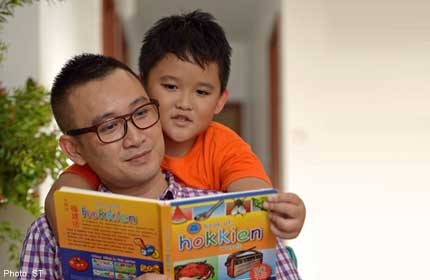Drawing people back to dialects and helping them reconnect

SINGAPORE - To teach his young nephew the names of some everyday items in dialect, social worker and art teacher Koh Kuan Eng drew flash cards.
Then his friends started asking for them as well.
Said Mr Koh, 46: "It got me thinking: How did I learn English and Mandarin, and how do children pick up their first few words? Picture books!"
So the former creative director of an advertising agency came up with a set of picture books depicting 50 everyday things that he named in Hokkien, Cantonese and Teochew.
He printed 1,500 copies in total out of his own pocket, half of which have already been sold, he said.
If you ever wanted to order an extra egg with your noodles in Hokkien but did not know how to, these books might help.
Mr Koh told The Straits Times: "I see dialect as an old friend we've lost touch with for a long time. Now I'm hoping to reconnect us with who we are and where we come from."
Mr Koh, who is single, learnt Hokkien and Teochew from his parents, and Cantonese from his neighbours.
He used all three dialects frequently, as he often helped his father tend their fish stall at the Maxwell Road market. Only dialects were ever spoken, he said.
His father is now 74 and retired.
He noted that while Singaporeans over the age of 40 can usually speak and understand dialects, those in their 20s or younger cannot do either.
The books marry his dialect skills and artistic abilities: He also teaches art at a special education school for children and, as a volunteer, he teaches senior citizens how to sketch.
The brightly coloured renditions of objects such as slippers, radios and bananas are drawn with simple black markers and watercolours.
Below each illustration is a rough romanisation of the name, though Mr Koh says pronunciations may vary from person to person.
BooksActually owner Kenny Leck said he was happy to stock the picture books.
"Imagine the number of stories and memories a typical 70-year-old has. They could be lost so easily without effective communication," he said.
"My dad's father could converse fluently only in Teochew. If I wanted to learn about our family history, or hear about the things my dad got up to, I could learn about them only in Teochew."
The picture books are being sold at BooksActually in Tiong Bahru and at Mr Koh's online store, www.sibeynostalgic.com.
He plans to produce editions in other dialects such as Hakka and Hainanese, and maybe phrase books too.
And by the way, the Hokkien word for egg is kuay neng.

Get a copy of The Straits Times or go to straitstimes.com for more stories.